King Edward I
The title of Prince of Wales was instituted in 1307 by King Edward I, when he invested his eldest son, Edward, as the first English Prince of Wales, at Lincoln. The traditional ostrich feather badge and the motto 'Ich dien' ( I serve) were adopted by Edward, the Black Prince after the battle of Crecy, they were previously believed to have belonged to the blind King John of Bohemia, who died in the battle.
(1) EDWARD OF CAERNARFON
The first English Prince of Wales was born at Caernarfon on 25 April, 1284, the fourth and eldest surviving son of Edward I and Eleanor of Castille. On the completion of his father's conquest of the province, he was created Prince of Wales on 7 February 1301, at the age of 16, at a parliament at Lincoln. Edward was married to Isabella 'the She-Wolf of France' daughter of Philip IV of France and Joan I of Navarre and had issue, which included the future Edward III.
He reigned as Edward II from 1307-1327. He was deposed by a rebellion lead by his wife and Roger Mortimer, Earl of March and forced to abdicate in favour of his son. Edward II was murdered in a bestial manner at Berkeley Castle in Gloucestershire. He was buried at Gloucester Cathedral.
(2) EDWARD OF WOODSTOCK, THE BLACK PRINCE
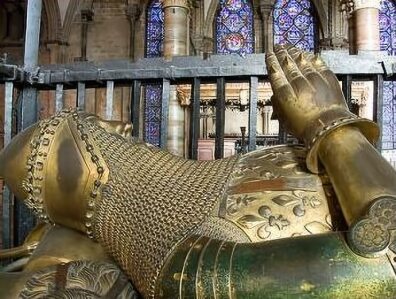
Edward of Woodstock, later known as the Black Prince for the colour of his armour, was born on 15 June, 1330, the eldest son of Edward III and Phillipa of Hainault. He was created Prince of Wales on 12 May, 1343, aged 12, at Westminster and was also Earl of Chester and Duke of Cornwall, making him the first English Duke. At fourteen he was amongst the first of the knights of the Order of the Garter, which was founded by his father.
He participated in the Hundred Years War with France and famously won his spurs at the Battle of Crecy, adopting as his personal emblem the Ostrich feather badge of the blind King John of Bohemia, who was killed in the battle. He also fought at the battle of Poitiers. Edward married his cousin, Joan, Countess of Kent, known as 'the Fair Maid of Kent', daughter of Edmund Plantagenet, Earl of Kent, the marriage was said to be a love match and produced two sons, Edward of Angouleme, who died young and the future King Richard II. The Black Prince was never to reign as King, he predeceased his father, dying on 8 June 1376. He was buried in Canterbury Cathedral, near the shrine of St. Thomas A' Beckett.
(3) RICHARD OF BORDEAUX
The second and eldest surviving son of Edward, the Black Prince and Joan, Countess of Kent, Richard was born on 6 January 1367 at Bordeaux. After the death of his famous father, he was created Prince of Wales on 20 November 1376, aged nine, at Havering.
He succeeded his grandfather, Edward III, as King Richard II in 1377. Richard married twice, firstly to Anne of Bohemia in 1383 and secondly to Isabelle of Valois in 1396, neither marriage produced issue. A volatile and brooding character, Richard proved an unpopular King and was forced to abdicate in favour of his cousin, Henry of Bolingbroke. He was either murdered or starved to death at Pontefract Castle in 1400, he was known to be certainly dead by 17 February of that year.
(4) HENRY OF MONMOUTH
The future Henry V was born in August or September, 1386-7 at Monmouth, the eldest son of Henry, Earl of Derby (the future Henry IV) and Mary de Bohun. On his father's accession to the throne he was created Duke of Lancaster and Prince of Wales on 15 October 1399, aged 12, at Westminster.
He succeeded his father in 1413. Due to his conquest of France, he was to become one of the most famous of the Plantagenet Kings and an English national hero. Henry married Catherine of Valois, the daughter of Charles VI, King of France and Isabeau of Bavaria the marriage produced one child, the future Henry VI. Henry V died of dysentery at Bois de Vincennes whilst on campaign in France on 31 August 1422. His body was returned to England where it was buried at Westminster Abbey.
(5) EDWARD OF WESTMINSTER
The fifth Prince of Wales, Edward, the only offspring of the marriage of Henry VI and Margaret of Anjou, was born on 13 October,1453, at Westminster. He was created Prince of Wales on 15 March, 1454, aged 5 months at Windsor.
After his father was deposed by the Yorkists, Edward shared his mother's French exile. In December 1470 he was married to Anne Neville, daughter of Richard Neville, later known to history as Warwick 'the Kingmaker', the marriage produced no issue. Whilst parcipitating in a campaign to restore his father to the throne, Edward was killed either during or after the Battle of Tewksbury at the age of seventeen on 4 May, 1471,there are several versions concerning how Edward, met his end, one states he was cut down as he fled north in the aftermath of the battle another states that following the rout of the Lancastrians at Tewkesbury, a small contingent of men under the Duke of Clarence found Edward near a grove, where he was immediately beheaded on a makeshift block, despite pleas for mercy to his brother-in-law Clarence.
An alternative version was given by three other sources: The Great Chronicle of London, Polydore Vergil and Edward Hall, which was the version used by Shakespeare. This records, that Edward, having survived the battle and was taken captive and brought before Edward IV who was with George, Duke of Clarence; Richard, Duke of Gloucester; and William, Lord Hastings. The king received the prince graciously and asked why he had taken up arms against him. The prince replied defiantly, "I came to recover my father's heritage." The king then struck the prince across his face with his gauntlet hand and those present with the king then suddenly stabbed Prince Edward with their swords. He was buried at Tewksbury Abbey in Gloucestershire.
(6) EDWARD OF SANCTUARY
The eldest son of Edward IV and Elizabeth Woodville, Edward was born in sanctuary at Westminster Abbey, on 4 November, 1470 during the brief restoration of Henry VI. He was created Prince of Wales on 26 June, 1471, aged 7 months, at Westminster.
He succeeded his father as Edward V on 9 April, 1483. His throne was usurped by his uncle, Richard, Duke of Gloucester. Edward and his younger brother, Richard, Duke of York, known as 'the Princes in the Tower' were imprisoned in the Tower of London and believed to have been murdered there. Bones which were discovered at the Tower in 1674 and assumed to be those of Edward V and his brother were re-interred at Westminster Abbey by order of Charles II.
(7) EDWARD OF MIDDLEHAM
Edward of Middleham was the only son of Richard III and his wife Anne Neville, previously the wife of the Lancastrian Prince of Wales (5). He was born around 1473 at Middleham Castle in Yorkshire and created Earl of Salisbury in 1478 and Prince of Wales amongst great celebration on 24 August, 1483 aged 10, at York Minster.
Known to be a delicate child, Edward died on 9 April, 1484, at about ten years old, possibly of tuberculosis and was buried at Sherrif Hutton Church in Yorkshire.
(8) ARTHUR TUDOR
Arthur Tudor the first Tudor Prince of Wales was born on 20 September, 1486 at Winchester, the son of Henry VII and Elizabeth of York, daughter of Edward IV. He was created Prince of Wales at the age of 3 on 29 November, 1489 and invested with the title on 27 February, 1490 at Westminster.
As part of a political alliance, Arthur was married to the Spanish Princess, Katherine of Aragon, daughter of the joint sovereigns Ferdinand of Aragon and Isabella of Castille, in November 1501 at St. Paul's Cathedral. He died at the age of sixteen, during an epidemic of sweating sickness at Ludlow Castle, in the Welsh Marches on 20 April 1502. He was buried at Worcester Cathedral.
(9) HENRY TUDOR
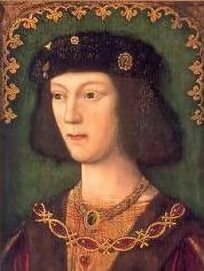
The future Henry VIII was born on 28 June 1491 at Greenwich, the second son of Henry VII and Elizabeth of York. He was created Duke of York in 1494 and after the death of his elder brother Arthur, Prince of Wales, was created Prince of Wales on 18 February 1504, aged 12.
He succeeded to the throne as Henry VIII 1509 and famously married 6 times. (1) Katherine of Aragon (2) Anne Boleyn (3) Jane Seymour (4) Anne of Cleves (5) Katherine Howard (6) Katherine Parr. Henry had issue from his first three marriages and all three of his children were to reign after him. He died on 28 January 1547 at the Palace of Whitehall. He was buried at St. George's Chapel, Windsor Castle and shares his tomb with his third wife, Jane Seymour.
(10) HENRY FREDERICK STUART
The first Stuart Prince of Wales was born on 19 February,1594, at Stirling Castle, Scotland, he was the eldest son of James VI of Scotland (later I of England) and Anne of Denmark and was named Henry Frederick after both his grandfathers. He became Duke of Rothesay, Earl of Carrick and Lord of the Isles from birth. On the accession of his father to the throne of England he was further made Duke of Cornwall in 1603.
He was created Prince of Wales on 4 June 1610, aged 16, at Westminster. Although a promising young man, Henry was never to reign as King, he predeceased his father, dying of typhoid on 6 November 1612 at the age of eighteen. He was buried at Westminster Abbey
(11) CHARLES STUART
Charles, the second Stuart Prince of Wales, was born on 19 November 1600 at Dunfermline Palace, Fife, the second son of James I and VI and Anne of Denmark. Charles was a delicate and sickly child who experienced difficulties walking and talking. He was made Duke of Albany in 1603 and Duke of York in 1605.
On the death of his elder brother Henry, he was created Prince of Wales in his place on 4 November 1616, at 15 years old, at Whitehall. He succeeded his father as Charles I in 1625. On 13 June 1625, he married Henrietta Maria of France, the youngest daughter of King Henry IV of France (Henry III of Navarre) and his second wife, Marie de' Medici.
Civil War broke out with parliament and Charles was tried and executed on the order of Oliver Cromwell, on 30 January, 1649, at Whitehall and buried in the tomb of a past Prince of Wales, Henry VIII, at St. George's Chapel, Windsor.
(12) CHARLES STUART
The future Charles II was born on 29 May 1630 at St. James' Palace, the eldest surviving son of Charles I and Henrietta Maria of France. He was Duke of Cornwall and Rothesay from birth and was created Prince of Wales around 1638-41 in London, aged 8-11. Due to the upheavals of the Civil War, he was never formally invested with the title. On the death of his father in 1649 Charles was already in exile.
Charles was restored to the throne in 1660 and married in 1662 the Portuguese Princess Catherine of Braganza, daughter of John II, Duke of Braganza and his wife, Luisa de Guzmán. King Charles II left no legitimate issue. He died of uremia on 6 February 1685 and was buried at Westminster Abbey.
(13) JAMES FRANCIS EDWARD STUART
James Francis Edward Stuart was born on 10 January, 1688 at St. James' Palace, London, the only surviving son of James II and his Italian second wife, Mary Beatrice of Modena. He was created Prince of Wales on 4 July,1688, at St. James' Palace and went into French exile with his parents on his father's vacating the throne after a rebellion lead by William of Orange.
On the death of his father he was declared 'James III' and recognised as such by Louis XIV of France. He married a Polish Princess, Maria Clementina Sobieski (1667-1737) daughter of James Louis Sobieski, the eldest son of King John III, and Countess Palatine Hedwig Elisabeth of Neuburg on 3 Sept 1719, by whom he had issue, Charles Edward Stuart, otherwise known as 'Bonnie Prince Charlie' and Henry Benedict Stuart, Cardinal York. Three failed Jacobite uprisings were led in his name, in 1715, 1719 and 1745, James died in Rome on 1 January 1766 and was buried within St.Peter's Basilica, the Vatican.
(14) GEORGE AUGUSTUS OF HANOVER
The first of the Hanoverian Princes of Wales was born at Schloss Herrenhausen, Hanover on 10 November, 1683, the only son of George Ludwig, Prince of Brunswick-Luneberg (later George I) and his first cousin, Sophia Dorothea of Celle. George's parents divorced in 1694. He was created Duke of Cambridge in 1706 and Prince of Wales on 27 September 1714, aged 30, after the accession of his father to the English throne.
He was married in 1705 to the German Princess Caroline of Anspach, daughter of John Frederick, Margrave of Brandenburg-Ansbach and Princess Eleonore Erdmuthe of Saxe-Eisenach by whom he had issue, including Frederick, Prince of Wales(15). George succeeded his father as George II in 1727 and died of an aortic dissection on 25 October, 1760. He was buried at Westminster Abbey.
(15) FREDERICK LEWIS OF HANOVER
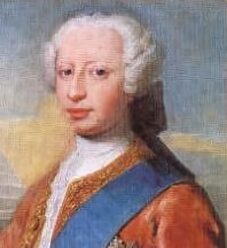
Frederick Lewis was born in Hanover on 1 February, 1707, the eldest son of George, Prince of Brunswick-Luneberg (later George II) and Caroline of Brandenburg-Anspach. He was created Duke of Edinburgh by his grandfather, George I, in 1726 and Prince of Wales on 8 January 1729 at London, at the age of 21.
Frederick married the Princess Augusta of Saxe-Gotha, the daughter of Frederick II, Duke of Saxe-Gotha-Altenburg (1676-1732) and Magdalena Augusta of Anhalt-Zerbst (1676-1740), by whom he had issue, including the future George III. Frederick never succeeded to the throne, having predeceased his father. He died at Leicester House in London of a burst abscess in the lung, on 31 March 1751 and was buried at Westminster Abbey.
(16) GEORGE WILLIAM FREDERICK OF HANOVER
The future George III was born prematurely on 4 June 1738 at Norfolk House, London, the eldest son of Frederick, Prince of Wales (15) and Augusta of Saxe-Gotha. He was created Prince of Wales after the death of his father by his grandfather, George II, on 20 April 1751, aged 12 years.
George succeeded his grandfather in 1760 and was married in 1761 to Charlotte of Mecklenberg-Strelitz, daughter of Duke Charles Louis Frederick of Mecklenburg-Strelitz, Prince of Mirow and his wife Princess Elizabeth Albertine of Saxe-Hildburghausen, by whom he had issue, including Kings George IV and William IV. Afte one of the longest reigns in British history, George died of porphyria at Windsor Castle on 29 January, 1820 and was buried at Windsor.
(17) GEORGE FREDERICK AUGUSTUS OF HANOVER
The last Hanoverian Prince of Wales was born at St. James' Palace, London on 12 August 1762, the eldest son of George III and Charlotte of Mecklenburg-Strelitz. He was Duke of Cornwall and Rothesay from birth. He was created Prince of Wales on19 August 1762 aged 1 week.
He became Regent in 1811 and King George IV in 1820. George was married twice, firstly and in contravention of the Royal Marriages Act, to Maria Fitzherbert and secondly to his first cousin, Caroline of Brunswick, the daughter of Charles William Ferdinand, Duke of Brunswick-Wolfenbüttel and Princess Augusta of Great Britain, by whom he had one child, Princess Charlotte of Wales. Princess Charlotte died in childbirth before her father. George died of a ruptured blood vessel in the stomach on 26 June 1830 and was buried at Windsor.
(18) ALBERT EDWARD OF SAXE-COBURG-GOTHA
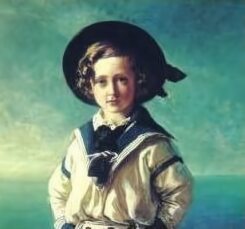
Prince Albert Edward was born on 9 November 1841 at Buckingham Palace, the eldest son of Queen Victoria and her husband Prince Albert of Saxe-Coburg-Gotha. He was created Prince of Wales on 8 December 1841 at 4 weeks old.
Albert Edward married Alexandra of Denmark daughter of Prince Christian of Schleswig-Holstein-Sonderburg-Glücksburg and Louise of Hesse-Kassel on 10 March 1863, the marriage produced six children, including the future King George V. His eldest son, Albert Victor Christian Edward died of pneumonia before his father.
He succeeded his mother in 1901 as Edward VII and became a popular King. Edward died at Buckingham Palace of bronchitis and a series of heart attacks on 6 May 1910. He was buried at Windsor Castle.
(19) GEORGE FREDERICK ERNEST ALBERT WINDSOR
The first Prince of Wales of the Windsor dynasty was born Prince George of Saxe-Coburg-Gotha on 3 June 1865 at Marlborough House, London, the second son of Edward VII and Alexandra of Denmark. He was created Duke of York by his grandmother, Queen Victoria in 1892 and Prince of Wales by his father on 9 November 1901 at the age of 36.
George married his second cousin once removed, Victoria Mary of Teck, the daughter of Francis, Duke of Teck and Princess Mary Adelaide of Cambridge, by whom he had issue, including Edward VIII and George VI. He succeeded to the throne in 1910 as George V. He died at Sandringham, Norfolk of a bronchial illness on 20 January 1936 and was buried at Windsor.
(20) EDWARD ALBERT CHRISTIAN GEORGE ANDREW PATRICK DAVID WINDSOR
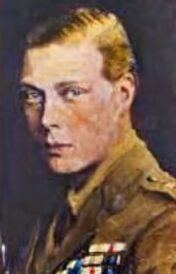
David, Prince of Saxe-Coburg-Gotha, as he was then called, was born at White Lodge, Richmond, Surrey on 23 June 1894, the eldest son of George, then Duke of York (later George V) and Mary of Teck. He was created Prince of Wales on 23 June 1910, aged 16 and invested with the title at Caernarfon Castle on 13 July 1911. He was a popular Prince of Wales and made several successful tours of the Empire.
He succeeded to the throne as Edward VIII on 20 January, 1936 and abdicated on 10th/11th December 1936 to marry the American divorcee, Wallis Warfield-Simpson. After his abdication, he became the Duke of Windsor and thereafter spent his life in exile. There was no issue from his marriage to Mrs Simpson, which took place in 1937, in France. He died of throat cancer in Paris on 28 May 1972 and was buried at Frogmore, Windsor.
(21) CHARLES PHILLIP ARTHUR GEORGE MOUNTBATTEN -WINDSOR
Prince Charles was born at Buckingham Palace on 14 November, 1948 the eldest son of the then Princess Elizabeth and Phillip Mountbatten. He was created Prince of Wales on 26 July 1958 aged 9 and invested with the title at Caernarfon Castle on 1st July 1969.
He has been married twice. firstly to Lady Diana Spencer in 1981, by whom he had issue and secondly to divorcee Mrs. Camilla Parker-Bowles, who is known as the Duchess of Cornwall, in 2005.
(22) WILLIAM ARTHUR PHILIP LOUIS
Prince William, the eldest son of Charles, Prince of Wales and Lady Diana Spencer was born on 21 June, 1982 at St. Mary's Hospital, Paddington, London. He was christened William Arthur Phillip Louis in the Music Room at Buckingham Palace by Dr Robert Runcie, Archbishop of Canterbury. William wore the Honiton lace christening gown made for Queen Victoria's eldest daughter, Vicky, which has traditionally been worn by members of the royal family ever since.
